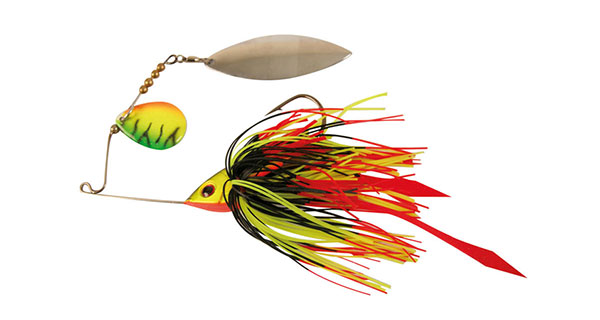
Do you ever wonder what a fish is thinking when he strikes a lure? I know I do. Biologists tell us that the usual reasons are hunger, curiosity, aggravation, and territorial defense. I don’t know how one determines whether a fish is striking because of hunger or aggravation, but I assume the scientists know what they’re talking about.
I can understand a fish striking a lure that closely resembles actual prey. Crankbaits, plastic worms, and especially trout flies fit this description. Other lures, such as spoons, don’t necessarily look the part, but have a flash and action that resembles baitfish. What baffles me is a lure like a spinnerbait. Not an in-line spinner, but the classic “safety pin” type, normally associated with bass fishing. There is nothing in nature that looks even remotely like a spinnerbait coming through the water. One semi-plausible explanation I’ve heard is that it looks like a “predator” (the body), chasing “minnows” (the blades). I’m not so sure. Every fish I’ve ever caught on a spinnerbait has been hooked inside the mouth. If a bass or crappie were going after the “minnows”, you would expect to occasionally hook one somewhere outside the mouth, especially when you consider the location of the hook.
What was the spinnerbait designer trying to imitate when he made the first model? Was it an intentional design or a desperate attempt to salvage a plan gone awry? What was his thought process? – “Let’s see, I’ll take some wire, bend it back on itself, attach some blades to one end and a chunk of lead, a plastic skirt and a hook to the other end, and tie up to the middle of the whole contraption. And then it will look just like a (you fill in the blank) when it comes through the water.”
We will probably never know, but whatever the origin, I’m glad the thing came together because the spinnerbait is my all-time favorite type of lure. There’s not a lot of middle ground – people seem to either love ‘em or hate ‘em, and I’m solidly in the former group. From tiny Beetle Spins to 1-ounce bottom crawling monsters, I’ve used them all. And yes, If I were stranded on the proverbial desert island with only one fishing lure, it would be some type of spinnerbait.
Another mystery for me are prop baits and other topwater lures that chug, spit, or pop. I don’t know what these lures are trying to imitate either. I’ve seen all shapes and sizes of insects, birds, rodents, reptiles and amphibians making their way across the top of the water and I’ve yet to see (or more accurately, hear) a single pop, chug, spit or buzz. In fact, any animal moving across the top always seems to be very quiet, making as little commotion as possible. Yet thousands of fish are caught on these lures every year.
Maybe this is where the curiosity strike comes into play. Perhaps a prop bait doesn’t sound exactly like a struggling shiner, but it sounds like something struggling, so a bass figures he’ll just smash it and if it isn’t edible, he can always spit it out. Maybe I’ll ask a biologist.
So for all you prospective lure designers out there, give all of your brilliant creations a thorough test under actual conditions before discarding them. Even if it doesn’t look exactly right or have the action you intended. You might just have the next spinnerbait sitting right there on your workbench.
See you on the water,
Eddie
